Technology Status of Hydrogen Road Vehicles
Technology Status of Hydrogen Road Vehicles
Technology Status of Hydrogen Road Vehicles
You also want an ePaper? Increase the reach of your titles
YUMPU automatically turns print PDFs into web optimized ePapers that Google loves.
A1.4 The Challenger Accident<br />
Certainly the space industry, and the Shuttle program in particular, cannot be compared with the more<br />
mundane activities <strong>of</strong> traditional industries, including a future hydrogen vehicle industry. Yet when such a<br />
common factor as safety <strong>of</strong> human life is involved, we must ask ourselves whether the chances <strong>of</strong> failure<br />
cannot be similarly high.<br />
Feynman (1986), an eminent scientist who formed part <strong>of</strong> the Presidential Commission that investigated the<br />
accident, stated:<br />
If a reasonable launch schedule is to be maintained, engineering <strong>of</strong>ten cannot be done fast enough<br />
to keep up with the expectations <strong>of</strong> originally conservative certification criteria designed to guarantee<br />
a very safe vehicle. In these situations, subtly, and <strong>of</strong>ten with apparently logical arguments, the<br />
criteria are altered so that flights may still be certified in time. They therefore fly in a relatively<br />
unsafe condition, with a chance <strong>of</strong> failure <strong>of</strong> the order <strong>of</strong> a percent (it is difficult to be more accurate).<br />
Official management, on the other hand, claims to believe the probability <strong>of</strong> failure is a thousand<br />
times less. One reason for this may be an attempt to assure the government <strong>of</strong> NASA perfection and<br />
success in order to ensure the supply <strong>of</strong> funds. The other may be that they sincerely believed it to be<br />
true, demonstrating an almost incredible lack <strong>of</strong> communication between themselves and their<br />
working engineers.<br />
This indictment may be peculiar to the space industry, but a skeptical public may not be so persuaded.<br />
The cause <strong>of</strong> the accident was simple enough. A rubber O-ring, intended to prevent hot gases from escaping<br />
through a joint between two lower segments <strong>of</strong> the solid rocket booster, could not expand properly at the cold<br />
ambient temperature <strong>of</strong> this launch. The escaping gases from the aluminum-based fuel booster acted as a<br />
torch, breached the LH 2 tank and ignited the hydrogen, resulting in the destruction <strong>of</strong> the vehicle.<br />
The psychological and other pressures on NASA differ from those on the automotive industry. But public<br />
relations, the strife <strong>of</strong> competition, and so on, can stifle the automotive engineer’s voice. If hydrogen with its<br />
new--not necessarily increased--risks is to become the fuel <strong>of</strong> the future, the safety culture in the organizations<br />
involved may need to be updated.<br />
30













